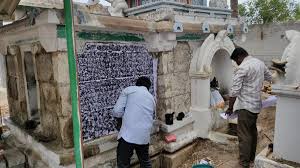The Hindu: Page 03
Syllabus : Prelims Fact

A team from the Archaeological Survey of India (ASI), Mysore, recently copied important inscriptions at Thalishwarar Temple, Kovilpalayam, using the ‘estampage’ method.
- Eight inscriptions, dating from the 9th to 12th centuries, were recorded.
- The findings, including hero stones and sculptures, will be studied and reported.
Inscriptions of Tiruppur:
- Historical Significance: Tiruppur, located in Tamil Nadu, India, is known for its ancient inscriptions that provide insights into the region’s historical and cultural heritage.
- Chola Dynasty: Many inscriptions date back to the Chola dynasty (9th to 13th centuries), reflecting administrative, religious, and economic aspects of the period.
- Temples: Inscriptions are often found in temples, detailing donations, land grants, and contributions made by kings, merchants, and local elites.
- Language: The majority of inscriptions are in Tamil, though some are in Sanskrit. They use the Tamil-Brahmi script and later the Vattezhuthu script.
- Notable Sites: Key sites with inscriptions include the Kalyana Venkateshwara Temple, Thalishwarar Temple and various ancient Shiva temples.
- Cultural Insights: The inscriptions reveal details about trade, social structure, and religious practices prevalent in the region.
Archaeological Survey of India (ASI)
- ASI, under the Ministry of Culture, is the premier organization for the archaeological research and protection of the cultural heritage of the nation.
- It administers more than 3650 ancient monuments, archaeological sites and remains of national importance.
- Its activities include carrying out surveys of antiquarian remains, exploration and excavation of archaeological sites, conservation and maintenance of protected monuments etc.
- It was founded in 1861 by Alexander Cunningham- the first Director-General of ASI. Alexander Cunningham is also known as the “Father of Indian Archaeology”.
The ‘Estampage’ Method:
- The ‘estampage’ method involves creating a detailed and exact replica of inscriptions by placing inked paper over the engraved surface and rubbing it to transfer the inscription’s impression.
- This technique captures fine details of the original text, making it easier for scholars to study and analyse the inscriptions without directly handling or disturbing the original artefacts.
- It’s commonly used in epigraphy for documentation and preservation purposes.
UPSC Prelims PYQ : 2023
Ques : With reference to the Indian History, Alexander Rea, A. H. Longhurst, Robert Sewell, James Burgess and Walter Elliot were associated with:
a) archaeological excavations
b) establishment of English Press in Colonial India
c) establishment of churches in Princely States
d) construction of railways in Colonial India
Ans: a)



